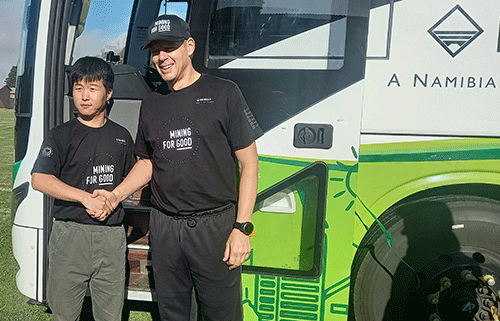ORANJEMUND – Namdeb on Saturday unveiled its electricity-driven bus as the very first of its kind in Namibia.
During the ceremony, the diamond entity’s CEO, Riaan Burger, said they realised that in the long-term, no business can claim to be a model one, geared for the future and also contributing to the world in the best way, without becoming operational on a carbon-neutral base.
The 65-seater bus runs on electricity-charged batteries, and it was manufactured in China within four months, although the projected period of completion was estimated at six months.
It can drive for 350 km, provided all batteries are fully charged.
“The intent for procuring the bus was to put it on trial as Namdeb’s first step of creating a carbon-free environment, replacing fossil fuels (petrol and diesel),” Burger stated.
Beyond this purchase, they will look at the remainder of the diamond mine’s transport fleet (buses, light vehicles and pick-ups) to also convert them from petrol/diesel to an electricity-driven mode.
‘’The aim in future is to change the electricity received from the grid in order to become carbon-neutral by means of introducing other means of generating energy – apart from electricity,’’ said the CEO.
The long-term plan for Namdeb is to become carbon-neutral by 2030.
Burger added: “It is obvious that when you introduce new technologies, you should also have different, specialised skills in place’’.
In this regard, drivers and electricity artisans are already undergoing training to drive the bus – and in addition, to maintain it, as no diesel mechanics will be needed, since the heavy-transport vehicle is operating without an engine.
‘’It is rather imperative that Namdeb should build technical capacity to deal with upcoming modern technology,’’ he reasoned.
When interviewed by New Era, Namdeb’s head of strategic projects Lionel Coetzee said the procurement of the bus is one of four different work streams the mine plans to operate on in future.
The first one is to reduce wastage and increase effectiveness by minimising the amount of carbon we commit for each of our activities – in the end, paying less for the same activity,’’ he reasoned.
Coetzee said the second workstream will be that of replacing the electricity from the Eskom grid with renewable electricity like wind turbines and solar systems in the near future.
“The work stream number there, under which the electricity bus resorts, is to change as much as possible the equipment running on diesel (bus) to electric-driven renewable energy equipment,’’ he said. The senior manager added that the final stream is to look for nature-based solutions, taking carbon out of the atmosphere sustainably.
In his contribution, Namdeb acting engineering manager Prokratius Kondjamba said after an exhaustive search for a suitable manufacturer for the bus from The Netherlands, Canada, Latin America and China, the latter proved to be the most responsive to their specifications.
“This bus is driven by eight modules of batteries at the front, middle and back, having a lifespan of eight years”, he explained.
They have also acquired two charging banks that are charged with electricity, whilst it takes two hours for a battery to be fully charged.
“The vehicle does not operate with a diesel engine like the others, and it has an automatic gearbox with only a reverse and forward gear, respectively,” he said.
It is equipped with air-conditioning, and it gives almost no sound when driven.
“The top speed is 120km/hour, but we governed it to 100km/hour to fit our safety standards and operations,’’ said Kondjamba.
Six drivers and 10 electrical artisans have been trained thus far to operate and maintain the bus.
The existing diesel-driven buses are mainly used to ferry staff between their workstations from designated pick-up points.
– sklukowski@nepc.com.na


